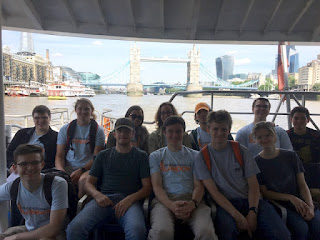https://youtu.be/lTSQpegZ4Ms A few photos from the banquet dinner at Brown's of Covent Garden are also provided. Emily Brown (IES Special Programs Coordinator) was our special guest. Congratulations EIL 2018 alumni!
Monday, July 2, 2018
Banquet and Slideshow
https://youtu.be/lTSQpegZ4Ms A few photos from the banquet dinner at Brown's of Covent Garden are also provided. Emily Brown (IES Special Programs Coordinator) was our special guest. Congratulations EIL 2018 alumni!
Friday, June 29, 2018
Royal Institution (Faraday Laboratory)
On Friday evening, June 29, the EIL Students along with Profs. Berry
and Parsons visited the Royal Institution (Michael Faraday Museum) near
Green Park. In addition to visiting Faraday's Laboratory, the students
attended a (Friday) Discourse lecture entitled "Are We Ready for the Next Pandemic" by Dr. Peter Piot (London School of Hygene and Tropical Medicine). In 1976, Dr. Piot co-discovered the Ebola virus in Zaire. His lecture was given in the Royal institution's lecture
hall, where Michael Faraday started the Christmas lectures in 1825. The
RI today is known for its science education programs, a continuation of
the tradition of scientific lectures as enlightened entertainment. The
Friday Night Discourses were formal affairs with the audience in evening
dress and the speaker by tradition had to start and stop his address as
the auditorium clock struck consecutive hours. J. J. Thomson announced
the discovery of the electron in his 1897 lecture in this room. The
Christmas Lecture program, begun by Michael Faraday and continuing
through today, is the oldest continuous science education program for
young people.
Wednesday, June 27, 2018
Warner Brothers Harry Potter Studios Tour
In the afternoon of Wednesday, June 27, EIL students and faculty set off to
Watford Junction (by train from Euston Station) and then to Leavesden
(by bus). They visited the Warner Brothers Harry Potter Studios to
observe the engineering magic needed to create all eight of the
blockbuster films. The group spend about three hours touring the studios,
eating dinner, and playing an intense round of Harry Potter trivia (for special prizes) in the cafe.
Saturday, June 23, 2018
London Water & Steam Museum (Kew Bridge)
On Saturday, June 24, the EIL students along with Profs. Berry and
Parsons visited the London Museum of Water and Steam (formerly Kew
Bridge Steam Museum) at Kew Bridge. They witnessed the startup of the Bolton and Watt Engine that was built in 1820 and moved to Kew Bridge in 1840. They were also shown the natural gas heated boiler used to produce the steam for all the engines in the Museum. Before
leaving the Museum, the students competed in a handheld boiler competition.
Bletchley Park
On Friday, June 23, the EIL students along with Profs. Berry and
Parsons and Emily Brown from IES visited Bletchley Park (north of
London). Bletchley Park is where Alan Turing and his colleagues broke
the Enigma code during World War II. The students witnessed
demonstrations of working Bombe, Tunny, Harwell Dekatron, and Colossus machines and were
given the opportunity to operate an actual Enigma machine. The Colossus
was the world's first electric digital computer that was programmable.
The Colossus computers were developed to help in the cryptanalysis of
the Hitler's Lorenz cipher. Nicknamed WITCH for Wolverhampton Instrument for Teaching Computing from Harwell, the Harwell Dekatron at the National Museum of Computing is considered the oldest electronic computer that is still operational. Our guides (Sheridan, John, and Tom) were
excellent and Professor Berry was given another vacuum tube and tape samples from the
working Colossus machine for the
display case in the Min Kao Building on the UT campus.
Friday, June 15, 2018
Greenwich
On Friday, June 15, the EIL students along with Profs. Berry and
Parsons took a Thames Clipper boat up the Thames River
to Greenwich. At Greenwich, they visited the Cutty Sark ship, Royal
Maritime Museum, the Queen's House, and the Royal Observatory. In the Time and Longitude Gallery of the Flamsteed House at the Royal Observatory, students were able to see Harrison's sea clocks from the eighteenth century. Harrison's H4 clock is considered the most important
timekeeper ever made. It is the machine that helped solve the problem of
keeping accurate time at sea and finally won Harrison huge rewards from
the Board of Longitude and the British Government. As is
customary, group photos were taken at the Prime Meridian (Latitude 0)
and with Southeast London as the background. Many of the students were wearing their EIL program
T-shirts.
Subscribe to:
Comments (Atom)


















































